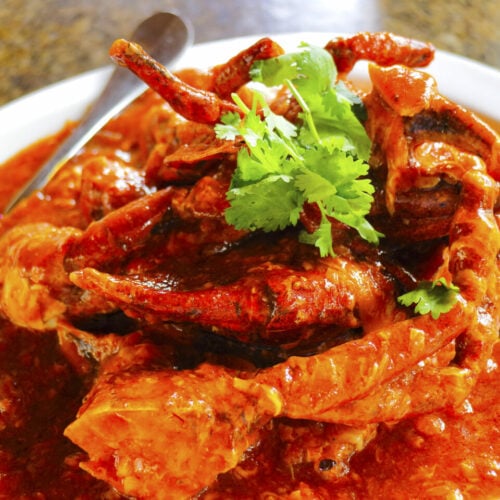
As the name implies, a sand crab is a tiny crab that burrows itself into the sand and feeds on plankton using its antennae. This tiny crab grows only up to two inches long and one inch wide, making it an unusual part of any seafood platter.
You can eat sand crabs, but only when they’re cooked. You’ll find their meat to be tender with a rich buttery taste, but they are so tiny that they contain very little meat. This is why it’s not so common to eat sand crabs.
Read on to learn everything about eating sand crabs, including their taste and nutritional value. You’ll also find some cooking tips, recipes, and precautions on how many sand crabs you can eat.
Table of Contents
What is Sand Crab?
A sand crab, also known as a mole crab, blue crab, or ghost crab, is a tiny crab that belongs to the family Hippidae of the species Emerita. As the name implies, you can see this crustacean on sandy beaches. It is a favorite bait in fishing and a typical food for birds.
This tiny crab, measuring only up to two inches, moves backward and quickly burrows itself in the wet sand for protection. However, since this small crab lives in the area of the ocean with the most algae, it tends to have domoic acid, mainly when found in areas with specific algae that produce it.
Unlike other larger crab species, they lack functional legs to help them maneuver walking in deep waters. Thus, they stay in the sand area and wait for the water to roll back to the sea to catch some plankton using their antennae. Smaller crabs feed on worms, algae, and mollusks, while larger sand crabs feed on carcasses and baby turtles.
Can You Eat Sand Crab?
Yes, you can eat sand crabs, especially the ones you see in clean beach sand and areas with little algae. However, you should never eat raw sand crab, as it may contain toxins, heavy metals, and bacteria that impose risks to human health.
What Do Sand Crabs Taste Like?
Sand crab meat is tender with a rich buttery taste. Most people compare its taste to tempura prawns or soft-shell crabs. Due to their taste and size, people often fry them and make them crunchy snacks.
Watch this video for a simple but delicious recipe.
Are Sand Crabs Healthy?
Like other seafood, sand crabs are a rich source of protein and healthy fat, including omega-3 fatty acids. On the other hand, sand crabs have lower fat and cholesterol content than other seafood.
However, sand crabs are also potential carriers of toxins they may get from the water or sandy beaches.
To be sure, avoid catching sand crabs from beaches near sewage systems, beaches with algae, and generally dirty beaches. You should never eat raw sand crabs. Clean sand crabs thoroughly with running water before cooking them to avoid health issues.
How Do You Catch Sand Crabs?
The first thing to consider is their size if you’re at the beach and want to get sand crabs or mole crabs. Female sand crabs are often larger than males, making them a better option for consumption.
When planning to catch sand crabs, you should have a rake or a net to help make your job easier. It’s also wise to consider the tide since high tide means a lesser chance of catching sand crabs. However, if you don’t have the time, you can purchase sand crabs in local supermarkets near beaches or find locals who catch and sell them at a lower price.
How To Prepare and Cook Sand Crabs
The easiest way to cook this crustacean is to boil it with water, salt, and spices. Or you can also deep fry it since its shell isn’t as hard as other crabs’. Sand crab meat is tender and has a buttery taste. Still, you can enhance it by adding a seafood boil seasoning mix and vegetables like corn, cauliflower, carrots, potatoes, and onions.
Here’s a simple recipe you can follow when cooking sand crabs:

Chilli Sand Crab
Ingredients
- 1 lb sand crabs
- 2 tbsp peanut oil or sesame oil
- 1 medium onion diced
- 3 cloves garlic minced
- 3 tomatoes diced
- 2 Thai chilies chopped
- 2 tsp lime juice
- 2 tbsp spring onion chopped
- 1 tbsp brown sugar
- 1 pc ginger thinly sliced
Instructions
- Wash the sand crabs thoroughly with running water, ensuring it’s free of sand and parasites.
- In a heated wok or pan, pour the oil and saute garlic, onion, tomatoes, and ginger.
- Add chili, and stir for about one minute. Then, add the sand crabs and mix for about one minute.
- Simmer for at least five minutes, then add sugar.
- Turn off the heat and add spring onions and lime juice. Serve warm.
Who Should Not Eat Sand Crabs?
Although sand crabs are edible, you should not eat them if you have any history of crustacean allergy, including allergic reactions to shrimp, crabs, lobsters, and crawfish. While seafood allergy is common, it can become severe when you consume large amounts of seafood.
Related Questions
Yes, you can eat sand fleas or beach fleas. A female sand flea is larger than male crabs, making it the ideal crustacean for consumption. You can also eat other crustaceans like a hermit crab, fiddler crab, and Dungeness crab.
Since a sand crab doesn’t have a hard shell, it only takes 10-15 minutes to prepare and cook it.
Sand crabs are prone to parasites, so be sure to check the crabs and wash them properly, even when you don’t see any parasites.
Sand crabs or blue crabs are common bait for fishing larger fish and are part of the diet of most sea birds.

Leave a Reply